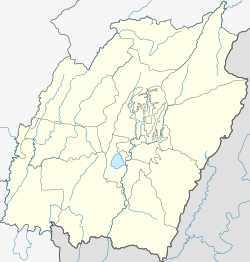Chakpikarong
| |
|---|---|
Town | |
| Coordinates: 24°19′N 93°59′E / 24.317°N 93.983°E | |
| Country | |
| State | Manipur |
| Founded by | Sumpi Dilthu |
| Town | Chandel |
| Government | |
| • Type | Democracy |
| • Body | Elected officials |
| • Rank | 23rd |
| Population (2011 census) | |
| • Total | 63,730 |
| Languages | |
| • Official | Anāl language (Naga) |
| Time zone | UTC+5:30 (IST) |
| ISO 3166 code | IN-MN-BI |
| Vehicle registration | MN |
| Website | chandel |
Chakpikarong is a town and subdivision of Chandel district of Manipur state in northeastern India. It is at the mouth of the Chakpi River, which joins the Manipur River at this location. The Anaal tribe is the majority in this region. Its history is deeply rooted with the history of the state. The literacy rate have boomed up in the recent years as transportation have developed.
Description
[edit]The place is inhabited by Anāl Naga tribe since time immemorial.[citation needed] Tuingan and Chapki river meet here. It is the home of Yangoupokpi-Lokchao Wildlife Sanctuary, which has an area of 185 km2 (71.4 sq mi).[1]
Languages
[edit]Anaal, a Sino-Tibetan language, is spoken here. A total of 140,000 residents of India speak the language, and more people in Myanmar also speak it.[2]
References
[edit]- ^ Indian Ministry of Forests and Environment. "Protected areas: Manipur". Archived from the original on 9 October 2011. Retrieved 25 September 2011.
- ^ M. Paul Lewis, ed. (2009). "Anaal: A language of India". Ethnologue: Languages of the World (16th ed.). Dallas, Texas: SIL International. Retrieved 28 September 2011.


Well, that’s interesting to know that Psilotum nudum are known as whisk ferns. Psilotum nudum is the commoner species of the two. While the P. flaccidum is a rare species and is found in the tropical islands. Both the species are usually epiphytic in habit and grow upon tree ferns. These species may also be terrestrial and grow in humus or in the crevices of the rocks.
View the detailed Guide of Psilotum nudum: Detailed Study Of Psilotum Nudum (Whisk Fern), Classification, Anatomy, Reproduction